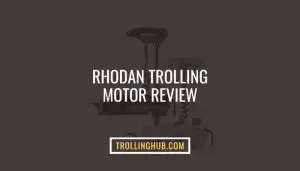Bass anglers consider trolling to be a misleading term, and it’s really prohibited in all bass competitions countrywide. However, it’s not only legal but also quite successful when it comes to catching fish for personal enjoyment.
Large schools of bass may be found by trolling, and this method is ideal for fishing in the middle of the day and it’s important that you know the right trolling technique and strategies.
This guide is based on years of experience, discussion with other anglers, and online research that will show you the right method for trolling bass. Keep reading to learn everything about trolling for bass.
Can You Troll For Bass
If you’re not sure what trolling is, let me explain it to you. When you are trolling, you pull your lures through the water as the boat moves slowly.
It is straightforward to fish using this method without gripping the rod or making any kind of presentation. The way the boat moves gives you a presentation.
Now you know what trolling is and trolling is a very perfect technique for catching bass and you can troll for bass no doubt.
Trolling for bass with crankbaits, swimbaits, and spinnerbaits is a highly effective method for locating bass holding to deeper structures or along submerged weed lines.
Trolling For Bass: The Right Techniques
Now you understand that trolling is applicable for bass catching then let’s explore the right techniques to use when trolling and the secrets to bass fishing. These have always worked for the majority of anglers, whether I’m deliberately targeting bass or just dragging my lure through the water on the way back to the launch.
Deep Water Trolling for Bass
Trolling is commonly used when the fish are extremely deep but concentrated in schools. This frequently occurs in the middle of the day when the temperature has reached its maximum.
When fishing in saltwater, deep-water trolling is most frequently employed, and this strategy is used when trolling for striped bass.
To reach depths, dodgers and planer boards are essential. Once there, striped bass anglers have traditionally preferred trolling spoons and crankbaits, but largemouth bass also takes them.
Remember that you’ll need to release a lot of line from your reel in deeper water. Until you do, your lure won’t be able to sink to the depth where the bass will be. More lines will need to be released as you troll faster in order for your lure to fall into deeper water.
Trolling on the Surface
Trolling on the surface is exactly what it sounds like. It requires dragging your lure over the water’s surface above the submerged object. Fishing using surface trolling might also be incredibly successful. When the bass is schooling and driving baitfish to the top, this is particularly true.
The best time to do this is when summer is coming to an end and temperatures have calmed down a bit, or when water temperatures start to drop in the evening on a summer night. The bass begins to come to the surface at this time to eat the nearby critters.
Bass will follow the baitfish as they move to the surface since they are a common element of their diet. Always keep in mind that the greatest region to find the bass is to first determine where its present prey are.
The best way to surface troll is to move your rod back and forth in long, slow motions to keep the bait in and out of the wake.
To prevent twisting, maintain the loose drag. You may further prevent this by attaching a snap swivel to the line. It is preferable to throw out at least 50 feet from the boat while trolling for largemouth bass and let the lure drogue behind.
Use a weedless rig if you’re trolling through weedy regions, and I recommend utilizing a jitterbug, chugger, or anything like that. Because the bait is presented exclusively by trolling through the water, you want a loud lure. The lure must produce some sort of noise because you don’t need to move it at all in order to attract any attention.
Trolling Planer for Bass
A trolling planer board is a device that enables numerous lines to be fished from the boat at the same time. Putting more lures in the water and improving your probability of catching fish helps you to maximize your fishing efforts.
Run your primary line from the rod into the water, attach it to the planer with a swivel, then run a secondary line from the planer a little deeper. The deeper you go, the heavier line I would recommend using.
If you’re fishing in deep water, you should probably use a 30-lb test line that is attached to your deeper line. You may place this line as far back as 100 feet.
The planer board stops as soon as the tension between the line pulling down and the board pushing out reaches its equilibrium point. In the end, there will be enough space to cast several fishing lines at once.
Triple planer boards let you retain three different depths at once, although most anglers use double planer boards. The enjoyment of fishing might be somewhat diminished by this unusual yet effective technique, but it’s crucial to have these types of alternatives when deep-sea fishing for striped or white bass.
Trolling Lures For Bass: Best Ones To Use
Trolling is an amazing fishing technique that does not require much skill, but one should deploy every technique one can to catch as much bass as possible.
While some techniques call for a dynamic presentation that includes a lot of jerking, rod lifting, and movement, others don’t require much at all. Bass fishing when trolling requires absolutely little presentation on your side; instead, you just sit back and let the motor and lure do their thing.
When trolling for largemouth bass, a few lures immediately come to mind: crankbaits, swimbaits, and spinnerbaits. Let’s explore each sort of bait and determine when each one should be hooked on for trolling bass.
Bass Trolling with Crankbait
A crankbait is my first choice of the lure while searching trolling for deep-water bass. Cranks are the most dependable method for locating aggressive open-water bass because you have to maintain your bait in the striking zone.
When trolling for bass, crankbaits are the most favored lure for the majority of anglers. Most anglers troll at speeds more than 2 mph, with speeds between 2.2 and 2.5 mph producing excellent results.
Don’t feel like you have to be locked in at a fixed speed if you aren’t catching any fish. Some fishermen do succeed at slightly slower or quicker speeds as well.
The color choice of the lures should match the watercolor. Choose a crankbait that strongly matches the colors of your surroundings if you don’t need many alternatives, and if you’re fishing in clear water, pick something more subtle. Choose a brighter lure if you are concerned that bass won’t be able to see it in the muddy water.
When trolling cranks, start shallow and go progressively deeper until you locate the bass. Troll until you hook up with a bass and then put out a marker or set a waypoint on your fish finder. Then, begin making precise lines with standard lure presentations all around the location where you got the bass. Keep trolling if you can’t get any more bites.
Swimbaits
Another great choice for bass trolling is swimbaits and their simple presentation works perfectly when trolling. Soft plastic-made swimbaits provide great action when trolling. Their natural buoyancy and single hook make them ideal baitfish imitators in shallow water.
Swimbaits should be used when fish are still in shallow waters but are not responding well to other presentations. A swimbait’s greatest advantage is that it enables quick and efficient trolling of huge areas of shallow water strike zones.
Given the depth they are used in, they also have the advantage of having a high level of weed and snag resistance.
We recommended using ⅜ to ¾ ounce heads with a 4 or 5-inch swimbait. Again, color selection is based on water clarity, so keep a variety on hand to accommodate varying weather.
Swimbait trolling is all about feeling, and with patience, you can cover water and catch a lot more bass on days with challenging circumstances.
Spinnerbaits
Spinnerbaits are among the best search baits in our opinion. Most Walleye anglers know about the efficiency of spinnerbaits and use long-line trolling methods that produce a lot of fish and you can use them for bass trolling as well.
Spinner baits have a look that matches baitfish, and the large blades act as dinner bells for bass. The spinnerbaits arm serves as a natural deflector to anything it could catch on in addition to holding the blade in place. These characteristics make spinnerbaits an excellent choice for bass trolling.
It is simple to become perplexed while choosing a spinnerbait due to the vast array of blade design, length, and color options. To troll for bass around deeper structures and weed beds, you need hefty spinnerbaits. Half or 3/4 ounces is enough to use.
Colorado blades are more effective at low speeds but less so at high speeds, producing higher pressure. Willow blades are more effective when moving quickly, making them a better option for trolling.
Color is less significant in clear water, although natural shades like white or silver are the standard approach. Again, in stained water, fire-tiger, chartreuse, orange, and green are best.
Trolling For Striped Bass
Trolling is still one of the most effective strategies for both novice and experienced anglers to catch large striped bass. The right lures and baits may be used to catch huge stripers when trolling.
Choose the right trolling gear and set them
Firstly you have to get the right types of trolling gear to start trolling for striped bass. Traditional reels that are spooled with braid, wire, and lead core line function well. Remember that wire may be challenging for beginners to utilize, and that weight will be needed to get most braid offerings down into the striking zone.
Speed Controlling
Trolling speed is one of the most important requirements in catching Striped bass. Trolling for striped bass requires comparatively slow boat speed. So make sure that your boat can travel slowly.
Depending on the trolling technique, slower speeds of up to 2 mph (3.2 km/h) may be required. If your boat does not idle at that pace, consider pulling buckets or a drift sock to slow it down.
Use your technique
The tube and worm technique is one of the most used trolling techniques. Bunker spoons, jigs, live eels, rigged dead eels, swimming plugs, umbrella rigs, mojo rigs, live mackerel, and porgies are just a few more methods that reliably catch big bass on the troll.
So use the technique on which you are the master.
Set everything properly
When trolling, make sure your drag is set to be both free enough to prevent breaking off a large fish and tight enough to ensure a strong hook set. For the initial hit, a drag pressure of 9–10 pounds is usually adequate.
Additional
You may purchase dependable color sonar equipment and a GPS system for detecting structure and striped bass holding places. Having decent gadgets will help you find hot places because there is a lot of empty water out there.
Best Time to Troll For Bass
Bass is intended to hunt and eat in low-light situations, thus in general, the ideal time of day to troll for bass is either early in the morning or later in the evening (dawn or dusk). Besides these, you may have some luck trolling bass in the middle of a rainy day when they are adapted to hunt and feed.
Trolling is a great way to catch big bass when they move from shallows water to deeper water in search of more moderate temperatures. Bass are simpler to locate in deeper water when these ideal situations are present since there is more oxygen there.
The best season to catch bass would be a mix between spring to summer when water temperatures are in the 60-8- degree range. June, July, and August are the top three months to troll bass.
The hours of 5:30 a.m. to 8:30 a.m. would be best suited for bass trolling in the early morning. Seasonal variations may apply, but generally, activity rises as you get closer to daybreak (while it’s still low light).
Low light conditions reappear in the late afternoon, giving the bass another excellent feeding period. Although topwater lures are also successful during these times, fishing in deeper water may be an option if it is exceptionally cold.
Trolling at night is always a good time considering the lack of other fishermen disturbing the fish and the ability of bass to see in low light.
Bass function better in low light, they do need some light to see so try to pick a night close to a full moon, with lots of moonlight to help you enjoy the tranquility to the fullest. But if it is a very dark and cold night then do not expect to find much bass.
If you do decide to try bass fishing at night, use noisy and large lures like spinners, poppers, or buzz bait that are large enough for the bass to feel in the dark water.
Winter bass fishing is slower because the bass is conserving energy and are typically in deeper water behind cover or ledges. Remember, the best time to catch bass in the winter is midday when the air and water temperatures are at their height.
The best time to bass trolling in the summer is around dusk or dawn when there is minimal light penetration. When the spawn is over, bass start feeding more actively. In this season they have their highest energy levels and will be found in shallow and deep waters.
FAQs
Bass like warmer water because they are cold-blooded. They are more active in warmer water because their metabolisms are faster in warmer water. As the water gets warmer, bass becomes more aggressive.
Speed is one of the most essential things about trolling. 2 to 4 mph is the best trolling speed for catching bass. If you go too fast the bass will not keep up, and they may feel intimidated and cross the lure. And if you are too slow, then they will get spooked
The bass generally bites better under conditions of extended low pressure. But this is not always right. It doesn’t mean that you can’t have a successful day of fishing when the pressure is high. You just need to fix your gear and apply your fishing techniques. Fishing is always better before the rain because this time the humidity is the highest and the barometric pressure is the lowest.
Bass are cold-blooded so they are most active and aggressive in warmer water. During the summer and fall days, the bass is most aggressive early morning from dawn until 2 hours after sunrise. And the same duration after evening they show their aggressive behavior.
Bass like both shallow and deep water depending on the season. As bass are cold-blooded, they like to stay in shallow water in the winter season. But in the summer and fall, they go down toward deep water and like to stay there. They stay deep until the water temperatures begin to warm up a bit in the spring.
Bass hide in different places in the lake like weed beds, docks, under a bridge, and entrances to shallow coves. You may also look for any submerged trees, logs, rocks, etc.
Crankbaits are great bass fishing lures all year. But different color baits are appropriate for different seasons. Orange, yellow, silver, and metallic colors are most intense during the summer season. Besides these green gizzard shad, sexy shad, and pro blue crankbaits are the colors you always should have on trolling in summer.
Final Thoughts
Whether you enjoy trolling or not, it may be a great technique to find bass in deep water rapidly in both the summer and the winter. Trolling absolutely works for bass, contrary to what you may have previously believed.
It works, but you need the appropriate technique, lures, and mindset. Although learning to trot could take some time, if you have an inquiring mind, you might expect to hear the bass in unexpected places.



